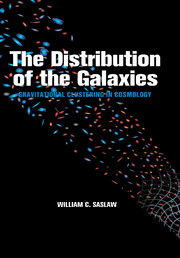Book contents
- Frontmatter
- Contents
- Prologue
- Part I Historical
- 1 Cosmogony Myths and Primitive Notions
- 2 First Qualitative Physics: The Newton–Bentley Exchange
- 3 Glimpses of Structure
- 4 Number Counts and Distributions
- 5 Seeds of Grand Creation
- 6 Clusters versus Correlations
- 7 The Expanding Search for Homogeneity
- Part II Descriptions of Clustering
- Part III Gravity and Correlation Functions
- Part IV Gravity and Distribution Functions
- Part V Computer Experiments for Distribution Functions
- Part VI Observations of Distribution Functions
- Part VII Future Unfoldings
- Bibliography
- Index
6 - Clusters versus Correlations
Published online by Cambridge University Press: 19 January 2010
- Frontmatter
- Contents
- Prologue
- Part I Historical
- 1 Cosmogony Myths and Primitive Notions
- 2 First Qualitative Physics: The Newton–Bentley Exchange
- 3 Glimpses of Structure
- 4 Number Counts and Distributions
- 5 Seeds of Grand Creation
- 6 Clusters versus Correlations
- 7 The Expanding Search for Homogeneity
- Part II Descriptions of Clustering
- Part III Gravity and Correlation Functions
- Part IV Gravity and Distribution Functions
- Part V Computer Experiments for Distribution Functions
- Part VI Observations of Distribution Functions
- Part VII Future Unfoldings
- Bibliography
- Index
Summary
What are they among so many?
John 6:9How should the irregular distribution of galaxies be described statistically? Are clusters the basic unit of structure among the galaxies, or is this unit an individual galaxy itself? Two new themes and the start of a theory emerged during the 1950s and early 1960s to answer these questions. One theme built rigorous multiparameter statistical models of clusters to compare with the catalogs. The other approach looked at basic measures of clustering, mainly the two-particle correlation function, without presupposing the existence of any specific cluster form. The theory successfully began Lemaître's program to calculate kinetic gravitational clustering in an infinite system of discrete objects – the problem whose root, we have seen, goes back to Bentley and Newton. All these developments were being stimulated by the new Lick Catalog of galaxy counts. More than a million galaxies were having their positions and magnitudes measured. Although this would supercede the catalogs of the Herschels, Dreyer, Hubble, and Shapley, its refined statistics would reveal new problems.
Neyman and Scott (1952, 1959) gambled on the idea that clusters dominate the distribution. Their model generally supposed all galaxies to be in clusters, which could, however, overlap. The centers of these clusters were distributed quasi-uniformly at random throughout space. This means that any two nonoverlapping volume elements of a given size have an equal chance of containing N cluster centers, regardless of where the volumes are.
- Type
- Chapter
- Information
- The Distribution of the GalaxiesGravitational Clustering in Cosmology, pp. 41 - 47Publisher: Cambridge University PressPrint publication year: 1999



